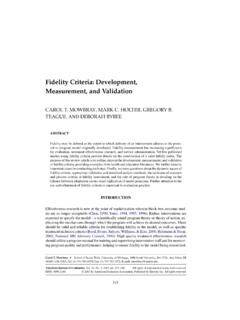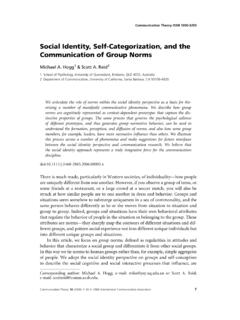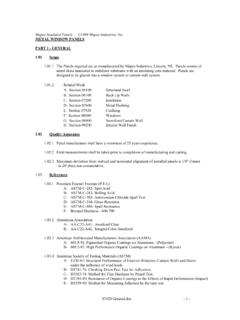Transcription of What is the Policy Problem? - ULiege
1 what is the Policy Problem? Methodological Challenges in Policy EvaluationANDERS HANBERGERUme University, SwedenBecause when a Policy process starts, nobody knows what line of action willeventually be implemented, Policy evaluation has to continuously examinethe content of different Policy components. In order to understand andexplain public Policy , different stakeholders perceptions of the policyproblem need to be scrutinized. A Policy evaluation should also facilitate theinterpretation of Policy in a broader context. what values and order doesthe Policy or programme promote? Using an open evaluation framework anda mix of criteria can facilitate a broader interpretation of the Policy this article, problems undertaking Policy evaluation are discussed inrelation to a Swedish medical informatics :lines of rationality; Policy evaluation; Policy learning; Policy problem ;stakeholdersIntroductionWhen a Policy process starts, nobody knows who gets what , When and How (Lasswell, 1958) or what line of action will eventually be implemented.
2 Where apolicy is made and implemented in multi-actor contexts, the various stakehold-ers frequently view problems and solutions differently and some will try to influ-ence the aim and direction of a Policy all the way through the Policy process. Thissituation calls for open evaluation frameworks and for more attention to be paidto different rationalities and lines of aim of this article is both to discuss the nature and the problems inherentin undertaking Policy evaluation, and to make a contribution to Policy evaluationmethodology. A postpositivist framework, developed to evaluate public Policy , isbriefly presented. Instead of a step-by-step account of the methodology, somesalient problems confronting Policy evaluators will be discussed more include: how to create Policy learning within a Policy process in generaland, more specifically, how to identify stakeholders in the Policy process; the defi-nition of the Policy problem ; evaluators intervention; and the differencesbetween rationality in theory and practice.
3 The article ends with a discussion ofimplications for evaluation 2001 SAGE Publications (London, Thousand Oaks and New Delhi)[1356 3890 (200101)7:1; 45 62; 017247]Vol 7(1): 45 624504hanberger (ds) 22/3/01 10:29 am Page 45 Nature of Policy EvaluationA basic characteristic of Policy evaluation is that changes generally take placethroughout the Policy process: the object of evaluation is a moving target. Someof these changes will affect the evaluation and some may cause problems to theevaluator. This is often the case in real-time evaluation, and because real-timeevaluations have become more common over the last 10 to 15 years, the questionof how to deal with Policy change in evaluation needs to be discussed evaluation (RTE) refers, in this article, to progressive forms ofpolicy evaluation that follow Policy processes underway. RTE scrutinizesdynamic processes. Such processes can be distinguished by uncertainty; forexample aims or means may change and new actors can enter the Policy , nobody can foresee what line of action will be implemented in theend.
4 The pre-condition of uncertainty implies that designing RTE is somewhatlike preparing to report a game without a referee. You know that there will beplayers out on the field, but you do not know how the game will proceed, whowill score or which team will win. The rules of the game might also change. Inreal-time processes, where stakeholders are involved, problem definitions, goals,actors, resources, restrictions etc. are not always known in advance, and thecontent of these components may change during the Policy process. If a real-timeevaluation should do justice to what is going on, and at the same time be usefulto practitioners in improving their practice, it needs to be sensitive to premise is that public Policy is generally developed in multi-actorcontexts. However, evaluators often overlook this or openly choose to give thecommissioners more influence on various parts of the evaluation, such as thedesign of the evaluation, the definition of the Policy problem , evaluation ques-tions and draft reports.
5 It is presumed that those who pay have the right to knowwhat they pay for and subsequently be given more influence. But, if the evalu-ation should do justice to the real conditions under which a Policy is made andimplemented, it must take into account different stakeholders views and argu-ments, including those who fail to influence the definition of the Policy , this is not generally the case in mainstream evaluations. Most policyevaluations are goal-oriented and biased to the commissioners different stakeholders arguments is more urgent today because thestate and its representatives no longer have unquestioned authority and legiti-macy. The state, and various levels of government, are actors in the policyprocess and should be treated on equal terms with others. The state s legal auth-ority and formal decisions do not inform us about how the implementation of apolicy will evaluation approaches have been developed to cope with problemsrelated to changes in Policy processes and to conditions in multi-actor contexts,and subsequently in response to shortcomings in goal-oriented and positivistevaluations (Fischer, 1995, 1998; Chelimsky, 1997; Cook, 1997).
6 One group ofresponses can be described as postpositivist responses and the framework pre-sented in this article is developed within this 7(1)4604hanberger (ds) 22/3/01 10:29 am Page 46 Postpositivist Policy EvaluationWhat characterizes the postpositivist response? First, it comprises a wide rangeof approaches and should be understood as a group of responses or alternativesrather than one clear and coherent approach. Postpositivists disassociate them-selves from rational, value-free, positivist assumptions. Critics of rational policyanalysis and evaluation argue that the first generation of value-free Policy analy-sis and evaluation was an illusion (Guba and Lincoln, 1989; Torgerson, 1986, 1992;Fischer and Forester, 1987; Deleon, 1994; Fischer, 1995, 1998). They questionwhether socio-political phenomena can be analysed by separating facts andvalues. They reject the positivist claim of being more scientific and the possibilityof arriving at one indisputable truth by using scientific methods and logic.
7 On thecontrary, postpositivists argue that social phenomena like public Policy need tobe scrutinized from different points of view and with various techniques. In orderto justify the use of multi-methodological approaches, which postpositivistsbelieve is necessary to obtain empirical validity, there is a need to anchor suchapproaches in some kind of pluralistic or relativistic epistemology. Thus, the post-positivist approaches belong to a pluralist and hermeneutic tradition (Albaeck,1989 90; Albaeck, 1995; Bernstein, 1983; Torgerson, 1985, 1995, 1996; Fischer,1998).There are three endeavours that unite most postpositivist analysts: they are allengaged in developing empirical, interpretive and critical enquiry (Bernstein,1976: 243 in Torgerson, 1985). They deliberately depart from a positivist and tech-nocratic world-view, and in different ways question scientific should be emphasized that some postpositivists seek to combine the bestfrom positivism and hermeneutics and do not think that methods used in posi-tivist analysis must be completely abandoned.
8 On the contrary, positivist tech-niques can be justified and used within a hermeneutic framework. Accordingly,when positivist methods and techniques are used by postpositivist evaluators,they are used critically, together with other methodologies, and withoutassumptions of scientific objectivism. The dichotomy between quantitative andqualitative methods is also questioned, primarily because all methods in somesense are qualitative. Postpositivists analyse all types of texts and sources anddo not assume that statistical methods and accounts generate more valid know-ledge. Discourse analysis, for example, can illuminate the basic conditions forpolicy making by scrutinizing what can be said and what is considered asrelevant knowledge within the dominant discourse (Fischer, 1995; Hansen,2000).Within this family of approaches, an evaluation can be framed in many ways,but no design can cover everything. All frameworks will be limited in scope anddepth.
9 However, knowing that an inquiry is always partial does not stop post-positivists from trying to capture the overall situation. Postpositivist evaluatorsseek to illuminate the value dimension in public Policy as well as in their ownaccounts, because all the stages in a Policy process and in an evaluation areimbued with : what is the Policy Problem? 4704hanberger (ds) 22/3/01 10:29 am Page 47 Policy Evaluation FrameworkTo cope with the dynamics inherent in Policy processes, a broad evaluation frame-work is suggested in this article. The framework is developed as part of the broaderpostpositivist discourse briefly described above. The overall purpose of the frame-work is to enhance practical and theoretical learning from the processes and out-comes of public Policy . The framework (see Table 1) shows the aspects anddimensions on which the evaluation will focus. It also serves as a checklist for gath-ering data (cf.)
10 Geva-May & Wildavsky, 1997: 7ff.; Costongs and Springett, 1997).The framework is constructed from four basic categories or components. Allfour components are essential to help understand and explain a Policy in itssocietal context. However, in practice real Policy processes do not follow thelogical steps implied in the framework sequentially. Therefore the four com-ponents or categories should not be associated with the rational assumptionsgenerally attached to various stages in a Policy process. Policy processes are inmany respects continuous processes and initiatives may start anywhere in thesystem (Hill, 1997b). The four categories serve the heuristic purpose of simplify-ing and structuring the evaluation of the Policy process without making anyassumptions about rationality or linearity. The evaluation will be carried out asan iterative and probing process and the evaluator must be prepared to gatherdata on all the components problem situation, the first component, provides the structure and direc-tion of the evaluation.









